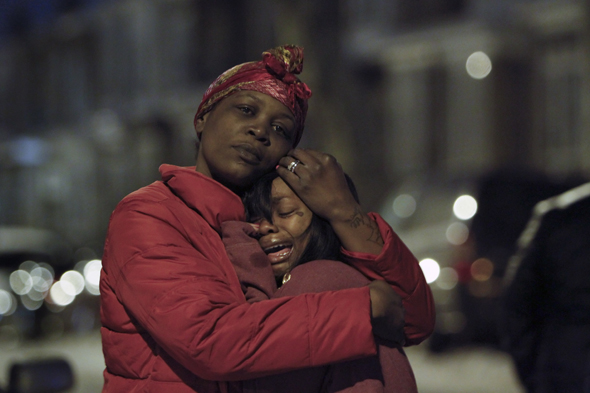
Wounded Family members of a gunshot victim on February 14 in the Feltonville section of Philadelphia. (Joseph Kaczmarek)
It’s just before midnight on a warm summer monday when photographer Joe “Kaz” Kaczmarek gets word of a double shooting on the 6500 block of Castor Avenue in Northeast Philadelphia. In less than 30 minutes he arrives on the scene, where a black baseball cap lays upside-down on the sidewalk next to a blood-soaked paper towel and a spent bullet casing outlined in chalk. Scott Small, the Philadelphia Police Department’s chief inspector, announces that a 43-year-old woman and her 55-year-old fiancé were shot a total of 12 times at close range. With two Canon cameras slung around his neck, Kaczmarek begins documenting the aftermath.
As cofounder of the Gun Crisis Reporting Project—a nonprofit devoted to covering Philadelphia’s epidemic of gun violence—that Monday was a typical day at the office for Joe Kaz. Nearly every night of the week, he is out photographing the scenes of gun-assisted crime in a city that has suffered one of the country’s highest homicide rates for nearly a decade.
Kaczmarek joined forces in March 2012 with former AP photographer Jim MacMillan. They wanted to create an online community that not only covered under-reported incidents of gun violence, but one that also presented possible solutions while avoiding politicized gun-control debates.
Over the past two-and-a-half years, the Gun Crisis Reporting Project has been sharing its collective wisdom with an ever-widening online community. Primarily, it serves as a hub for fellow Philadelphians who are interested in raising awareness of the city’s murder problem. And yet through lectures, public forums, and original reporting, it also puts a spotlight on local groups that are pursuing unorthodox solutions to gun violence. Like the three-year-old Philadelphia CeaseFire, for instance, which is modeled on Chicago’s Cure Violence project that treats violence as a public-health issue that can be prevented through intervention and education. After a year of outreach in the city’s troubled 22nd Police District, shootings dropped there by 11 percent and homicides by 21 percent.
Still, it isn’t unusual to see multiple reports of unsolved shootings in a single day at GunCrisis.org, the project’s website. On its Twitter stream, disturbing images sometimes appear on an hourly basis. The project was almost entirely bootsrapped and is run by volunteers. And yet, due to shrinking budgets at the town’s two daily newspapers, many of Kaczmarek’s and MacMillan’s crime-scene photos, and the written roundups that accompany them, are often the only public records that an act of gun violence has taken place in Philadelphia.
“I love this city,” MacMillan says. “I’ve been here almost 25 years. So why did I start this? Because I had to.”
Dan Eldridge is a freelance journalist in Philadelphia and the co-owner of Kaya Aerial Yoga. Follow him on Twitter @YoungPioneers.
